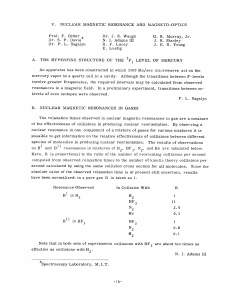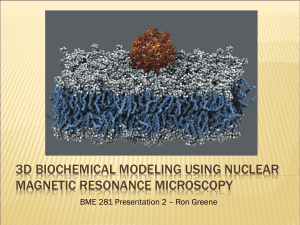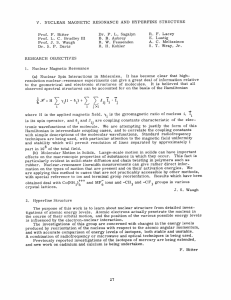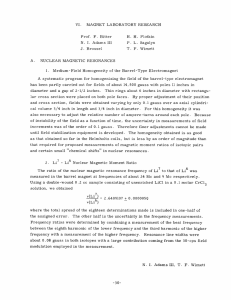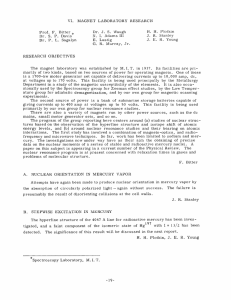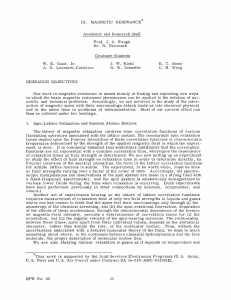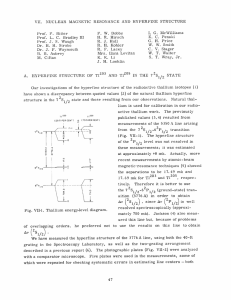NUCLEAR MAGNETIC RESONANCE AND HYPERFINE ... VI. Dr. P. L. Sagalyn
advertisement
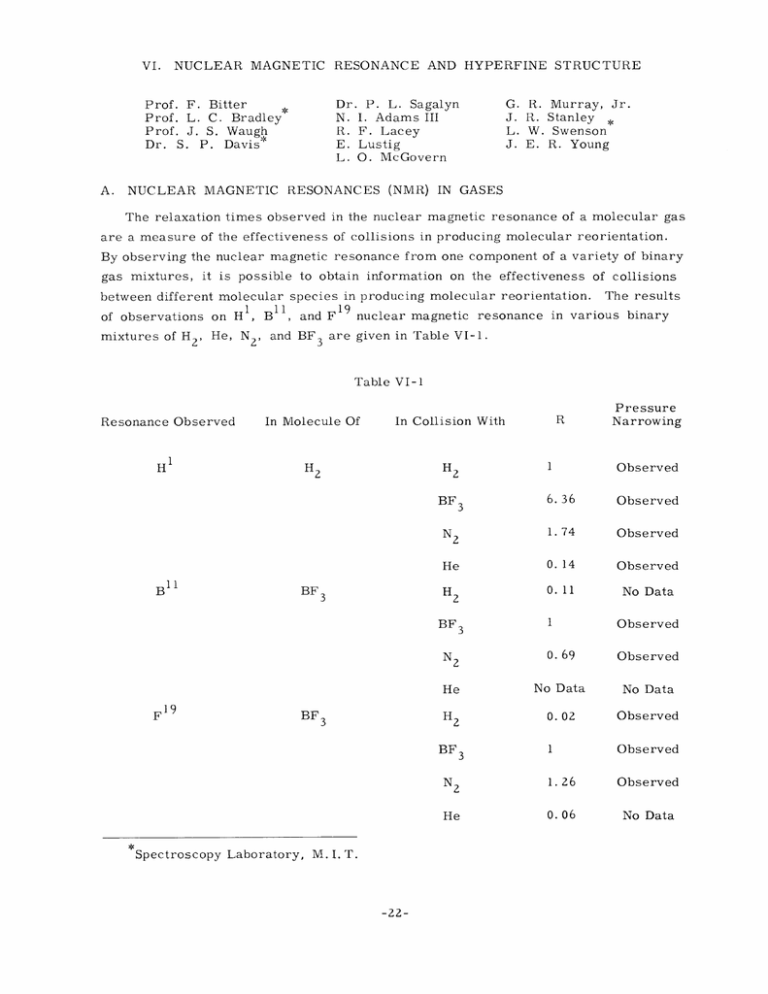
RESONANCE AND HYPERFINE STRUCTURE NUCLEAR MAGNETIC VI. Dr. P. L. Sagalyn N. I. Adams III R. F. Lacey E. Lustig L. O. McGovern Prof. F. Bitter Prof. L. C. Bradley Prof. J. S. Waugh Dr. S. P. Davis* A. NUCLEAR MAGNETIC G. J. L. J. R. R. W. E. Murray, Jr. Stanley Swenson R. Young RESONANCES (NMR) IN GASES The relaxation times observed in the nuclear magnetic resonance of a molecular gas are a measure of the effectiveness of collisions in producing molecular reorientation. By observing the nuclear magnetic resonance from one component of a variety of binary gas mixtures, it is possible to obtain information on the effectiveness of collisions between different molecular species in producing molecular reorientation. 1 of observations on H , B'1, and F mixtures of H 2 , He, N 2 , and BF 3 19 The results nuclear magnetic resonance in various binary are given in Table VI-1. Table VI-1 Resonance Observed H 'I In Molecule Of H B BF 3 Pressure Narrowing 1 Observed 6. 36 Observed N2 1.74 Observed He 0. 14 Observed H 0. 11 No Data H2 2 BF 11 R In Collision With 3 2 1 Observed 0. 69 Observed He No Data No Data H 0.02 Observed 1 Observed 1.26 Observed 0.06 No Data BF 3 N F19 F BF 3 2 2 BF 3 N 2 He Spectroscopy Laboratory, M. I. T. -22- NUCLEAR MAGNETIC (VI. RESONANCE AND HYPERFINE STRUCTURE) R is proportional to the ratio of the number of reorienting collisions per second (as computed from the observed nmr relaxation times) to the number of kinetic theory collisions per second (as calculated with kinetic theory collision cross sections for the Since the absolute values of relaxation times are less certain than various molecules). ratios, results have been normalized in Table VI-1 in such a way that for a pure gas R equals 1. For most of the mixtures, data were taken at more than one pressure so that a check could be made of the expected "pressure narrowing." In all cases for which data were taken, pressure narrowing did indeed occur. The occurrence of pressure narrowing supports the theoretical model (1) in which the relaxation depends on the motion of the molecule containing the resonant nucleus. This model is also supported by the roughly similar variations with mixture of the relaxation times of B11 and F 9 . This is because one would expect marked differences in the variations with mixture if the interaction of the nmr nucleus and the other molecule were direct, since B11 has a quadrupole moment and F19 does not. The absolute values of the fraction of collisions effective in producing reorientation of the nmr molecule can be obtained by use of the absolute values of the relaxation times and a (theoretical) estimate of the strengths of all interactions between the nmr nucleus The observed relaxation times were: for H in pure H2, 0. 3 msec per m 19 11 in pure BF 3 , 1.4 in pure BF 3 , 20 msec per atmosphere; for F atmosphere; for B and its molecule. msec per atmosphere. Only for H 2 is a good estimate of the strength of the nmr molecule-nmr nucleus We find that only about one HZ-H interaction available (1). Z collision in fourteen produces reorientation. In BF 3 the ratio of interaction strengths of B l and F 19 as deduced from the relaxa- tion time ratio indicates that the quadrupole interaction of B less important than the B symmetry of the BF neglecting the B 11 3 1 dipole interaction. with the molecule is much This seems reasonable in view of the molecule and the small size of the B 11 quadrupole moment. Thus, quadrupole moment, using a simple estimate of the magnetic inter- actions, we find from the combined F 19 and B11 data that about one BF3-BF 3 collision in ten produces reorientation. A more detailed report on this experiment, now completed, appears in reference 2. N. I. Adams III References E. M. Purcell, and R. V. Pound, Phys. Rev. 73, 679 (1948). 1. N. Bloemberger, 2. N. I. Adams III, Nuclear magnetic resonance in gas mixtures, Ph. D. Thesis, Department of Physics, M.I.T. (1955). -23- (VI. NUCLEAR MAGNETIC RESONANCE AND HYPERFINE STRUCTURE) B. NUCLEAR MAGNETIC RESONANCE IN SOLIDS 1. Molecular Motion in Ionic Crystals Octohedral cobalt salts of the type (Co(NH 3 )aX 6 -a)Y a- 3 where X and Y are singly charged anions, are being studied because of the variety of controllable structure changes whose effects can be investigated. Recent improvements of the apparatus (a regenerative spectrometer) have made possible the accumulation of final data on the +++ proton line shapes in four salts of the Co(NH 3 ) 6 ion. These appear to be in accord with the occurrence of two thermally activated processes: (a) reorientation of ammonia molecules about their threefold axes, and (b) tumbling of the ion as a whole in the cubic lattice potential. The former sets in at a lower temperature than the latter. The line shape at all temperatures appears as a superposition of three simple components whose relative sizes vary with temperature. Contributions to the widest component may arise from an impurity such as the corresponding salt of the Co(NH 3 ) 5 X + + ion. Further analysis of the data on these and other salts is in progress. Relaxation time measurements will shortly be attempted in order to obtain accurate values of barrier energies, which we then hope to correlate with the crystal structures and macroscopic properties of the crystals. 2. Molecular Motion in Acetylenic Hydrocarbons The thermal behavior of the proton resonances in dimethylacetylene and dimethyldiacetylene is being investigated in order to determine the nature of the second-order phase transition in the former, and to investigate crystal barriers to rotation of methyl groups in substances with negligible intramolecular barriers. The relaxation time is long in both substances, making it difficult to obtain suitable data with the regenerative spectrometer. Projected measurements by a bridge technique are expected to ameliorate this situation. Other related compounds will also be investigated. J. S. Waugh, G. R. Murray, Jr., C. OPTICAL INVESTIGATIONS 1. Hyperfine Structure of Hafnium Isotopes Work is going forward on optical studies of hyperfine structure. and E. Lustig This involves examination of line spectra with a high resolution instrument, usually a Fabry-Perot interferometer. At present the element under study is hafnium; the nuclear moments of hafnium 177 and 179 are unknown, and the isotope shifts are of interest. This metal has proved unusually difficult to excite in a hollow cathode, which is the light source now being used for this work. It is hoped that a recent modification of the power supply, -24- (VI. NUCLEAR MAGNETIC RESONANCE AND HYPERFINE STRUCTURE) which makes operation more stable, will remedy this. Another study is being started in an attempt to use a microwave discharge for the excitation of microgram quantities of material. The equipment has been assembled, but no experiments have been undertaken as yet. L. C. Bradley, L. W. Swenson 2. Hyperfine Structure of Radioactive Cadmium 0 9 , for the An attempt has been made to observe the optical hfs of radioactive Cdl purpose of determining its spin and magnetic moment. The cadmium was obtained from Dr. G. Hine, of the Boston Veterans' Hospital Radiological Laboratory. It was made by the Ag 07(a, pn) reaction, during a three-hour bombardment in the M. I. T. cyclotron. The cadmium was separated from the silver target by an ion exchange method. The yield, as determined by the counting rate, was approximately 1013 atoms. Even though this amount was considered too small by a factor of 10 for excitation in an electrodeless discharge, a tube was made for the purpose of determining to what extent impurities A preliminary examination of the spectrum indicates no cadmium, as expected, and several impurities in fairly large quantities. The exact nature of the were present. contaminants is now being determined. L. O. McGovern, S. P. Davis 3. The Isotope Shift of Mercury 197-197 Although the hfs components of the resonance radiation of several radioactive isotopes of mercury prepared by bombarding gold with deuterons have been observed (1), the identification of the various components has not been satisfactorily completed. An apparatus involving magnetic scanning and detection by absorption (2) has been completed, and under suitable conditions the percentage absorption is proportional to the number of atoms present. With this apparatus it is hoped to observe the decay time for each hfs component, and thus to make positive assignments of lines to the various isotopes present. J. E. R. Young References 1. F. Bitter, S. P. Davis, B. Richter, and J. E. R. Young, Phys. Rev. 96, 1531 (1954). 2. F. Bitter, Technical Report 292, Research Laboratory of Electronics, M. I. T., March 16, 1955. -25-
